Achiote: the ancestral secret of Mexican food
In Mexican cuisine, there is an ancient condiment capable of giving color, aroma, and a deep flavor to any dish.
RECETASINGREDIENTES DE LA REGION
Ro Madrid
7/23/20253 min read


Achiote: The Ancestral Secret of Mexican Food That Transforms Your Recipes
In Mexican cuisine, there exists an ancestral condiment capable of giving color, aroma, and a deep flavor to any dish. If you’ve ever wondered why cochinita pibil has that characteristic reddish tone and an unmistakable smoky flavor, the answer lies in a single word: achiote. But this condiment is not just for one dish; it is a culinary treasure that is an essential part of traditional and gourmet Mexican food. Keep reading and discover why achiote is one of the most valued condiments for Mexican food, both in home kitchens and in Bib Gourmand restaurants in Tulum.
What is Achiote and Where Does it Come From?
Achiote comes from the seeds of the shrub Bixa orellana, native to Mesoamerica. The Maya had already been using it for centuries, not only as a condiment but also as a natural dye and medicine. In cooking, achiote is mainly used in the form of paste or powder. Its intense red color and slightly earthy flavor, with smoky and spiced notes, make it perfect for enhancing dishes such as pollo pibil, tamales, lechón tacos, and many other recipes with achiote.
Achiote in Mexican Food: Much More Than Color
Achiote not only provides color. It is part of the soul of many traditional recipes. Its flavor is particularly activated when mixed with acids like sour orange juice, vinegar, or lemon juice. This makes it a key ingredient in the preparation of marinades and adobos.
Among the most well-known uses is cochinita pibil, a Yucatecan dish that has crossed borders. It consists of pork marinated with achiote paste, sour orange juice, and spices, then cooked slowly wrapped in banana leaves. The result is juicy meat, full of flavor and color, perfect for tacos or tortas.
Benefits of Achiote
In addition to its gastronomic value, achiote also provides health benefits:
It is rich in antioxidants.
It has anti-inflammatory properties.
It has traditionally been used to improve digestion and relieve skin issues.
These benefits make it an ingredient that not only enhances flavor but also cares for your health.
Restaurants in Tulum Celebrating the Flavor of Achiote
Tulum has become a reference for Mexican food in its gourmet version. Restaurants included in the Michelin Guide, such as those that have received the Bib Gourmand distinction, celebrate traditional ingredients like achiote.
In places like Cetli Tulum, a sanctuary of moles and ancestral flavors, achiote is used with respect and creativity. You can also find its influence in modern signature dishes at restaurants like Hartwood, Arca, or Nü, where local ingredients shine in every recipe.
The presence of these establishments in the Michelin Guide not only validates their quality but also positions Tulum as an ideal destination for those seeking the best gourmet Mexican food in Tulum.
How to Use Achiote at Home? Basic Marinade Recipe
A simple recipe for marinating meat with achiote:
Ingredients:
100 g of achiote paste
1 cup of sour orange juice (or a mix of orange and lemon)
2 cloves of garlic
1 teaspoon of dried oregano
Salt to taste
Instructions:
Dissolve the achiote paste in the orange juice.
Add chopped garlic, oregano, and salt.
Marinate the meat (preferably pork or chicken) for at least 4 hours.
Cook in the oven, on the grill, or steam.
This marinade is the base for many iconic dishes of Yucatecan cuisine.
Frequently Asked Questions About Achiote
Is Achiote Spicy?
No. Achiote has a mild, earthy, and slightly bitter flavor, but it is not spicy.
Where Can I Buy Achiote?
It can be found in local markets, stores that sell Mexican products, and supermarkets. It comes in powder, paste, or grain form.
Can I Use Achiote in Recipes That Are Not Mexican?
Of course! You can experiment with achiote in marinades, rice, soups, and meats in different cuisines around the world.
Conclusion
Achiote is much more than a condiment: it is history, culture, and flavor in every gram. Present in traditional recipes such as cochinita pibil or in proposals of gourmet Mexican food in Tulum, this ingredient connects the past and present of Mexican gastronomy. If you visit restaurants in Tulum recognized by the Michelin Guide, don’t forget to try dishes that include it. And if you cook at home, achiote is an easy way to bring the soul of Mexico to your table.






